“I like it when work is a conscious reflection of the artist’s tastes and values” Luke Healy
 For his follow up to the critically acclaimed How To Survive In The North, artist Luke Healy has teamed up with the excellent Avery Hill to produce a collection of three stories abot communication and miscommunication which bridge together to from one over arching graphic novel. We catch up with Luke to find out more about how these stories connect and how they reflect his own world view.
For his follow up to the critically acclaimed How To Survive In The North, artist Luke Healy has teamed up with the excellent Avery Hill to produce a collection of three stories abot communication and miscommunication which bridge together to from one over arching graphic novel. We catch up with Luke to find out more about how these stories connect and how they reflect his own world view.
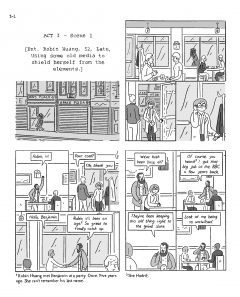 Your new book Permanent Press is coming soon from Avery Hill, can you tell us a bit about how the project came together – did you pitch it to them or did they approach you to create the book? Is it a collection of previously assembled work or is it all new work for this collection?
Your new book Permanent Press is coming soon from Avery Hill, can you tell us a bit about how the project came together – did you pitch it to them or did they approach you to create the book? Is it a collection of previously assembled work or is it all new work for this collection?
Luke Healy: So, Permanent Press collects two stories, The Unofficial Cuckoo’s Nest Study Companion and The Big and Small, with around 50 new pages of comics that bridge them into one big graphic novel.
I wrote Cuckoo’s Nest in 2015 while working on my first graphic novel, How to Survive in the North, and then illustrated and self published it in early 2016. Dave from Avery Hill picked up a copy at ELCAF last year, which is how I got on his radar. That summer I was also self-publishing The Big and Small on twitter, which Dave liked. He reached out to me to see if I’d be interested in publishing it with Avery Hill, and I responded by pitching him this larger project that collects both stories.
It starts with a story about a frustrated comic artist and his shadowy muse, is this your way of channelling your own writers block and frustrations about writing? Or does it takes inspirations from your peers tale of frustration? Were you trying to offer solutions as much as documenting your problems?
LH: That part of the story (about a cartoonist called Luke Healy) is not really autobiographical in that it doesn’t depict real events. It’s supposed to be more like a self-portrait of the person I was in my early twenties, when I took comics way too seriously, and was really hungry for recognition.
I’ve never really suffered from writers block, but certainly many aspects of the comics-making career path used to frustrate me to no end. I had plenty of inspiration to choose from!
I’m not sure if the book offers solutions exactly, but I hope that if it communicates any message to younger cartoonists/creatives, that message is “chill out”.
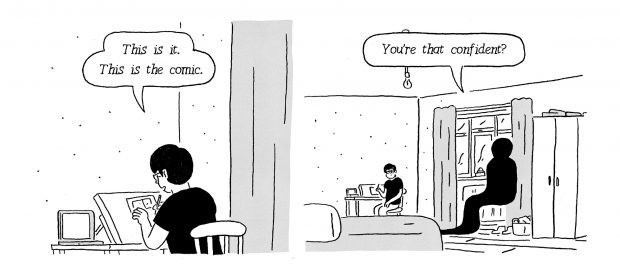
In the second story Cuckoos Nest you seem to really revel in using unconventional elements to tell the story – mixing in bits of script, different narrative perspectives, even a bit of multi-media – did this style evolve as you wrote the story, or did you plan it out to use these unique ways of telling a story?
LH: I planned to mix media from the story’s inception. I wrote Cuckoo’s Nest while I was deep in the middle of How to Survive in the North. I wasn’t used to working on something so lengthy. Back then, when I had an idea for some new technique or gimmick, I would usually just make a short story that incorporated it. But working on How to Survive didn’t leave me with enough time to draw anything extra, so I just wrote all of my ideas into Cuckoo’s Nest.
After handing in How to Survive, I took two weeks off, and then drew Cuckoo’s Nest, which felt like a big release.
The central theme of Cuckoo’s Nest is communication and miscommunication. I knew that I wanted to use mixed media before I knew what the story would be about. I was already planning to include play script and prose as a part of the storytelling language of the book, so it felt right to incorporate them into the subject matter as well.
So it became a story about a group of people trying and often failing to communicate with each other, using these media of prose writing, script writing and performance.
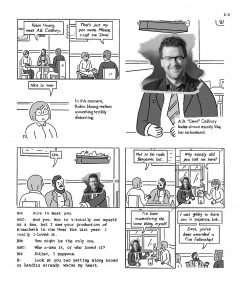 The way the characters interconnect and the book affects all their lives – Robin’s daughter studying it at school, her teacher being the partner of the set designer etc. – is a really interesting microcosm of the world and how we are all interconnected in a way. Was that part of the idea behind it?
The way the characters interconnect and the book affects all their lives – Robin’s daughter studying it at school, her teacher being the partner of the set designer etc. – is a really interesting microcosm of the world and how we are all interconnected in a way. Was that part of the idea behind it?
LH: I think the intricacy of the characters’ world is more a result of how much time I had to work on writing that story. It was the first time I’ve made a concerted effort to work in drafts, writing and rewriting the story until it all completely clicked (and in this case, until I had any time to actually draw it).
Seeing a new connection emerge, as a reader, is such a pleasurable feeling that, as a writer, I was unable to resist inserting them whenever they came to mind.
The third story starts as a comparison piece between the lives of two people – one large and one small – and the differences and similarities of their lives – was this inspired by real life people, or did you just develop and create them and their own unique personas as the stories evolved? It feels like it really reflects that idea of people being interconnected that you mentioned in the previous question?
LH: This story, The Big and Small, came together in much the opposite way that Cuckoo’s Nest did. I had just taken a full year off from making comics, and I wanted to get back into making things without too much delay. This story was written as I went along, page by page, and published on twitter.
All I knew at the inception was that I wanted it to be about communicating with numbers, much in the same way Cuckoo’s Nest was about communicating with words. It is supposed to serve as a kind of mirror story to Cuckoo’s Nest, reflecting the same themes and ideas through a different lens. So for example, the two lead characters look like slightly altered versions of the leads of Cuckoo’s Nest.
Otherwise, it was all fairly improvised as I published it. I had a few ideas for who the characters would be before I started writing and drawing, but they’re not based on real people, and they ended up evolving in a fairly organic way. Once Avery Hill expressed interest in publishing the longer book, I went back and made some major edits to this story particularly, to smooth everything out, and keep it thematically focussed.
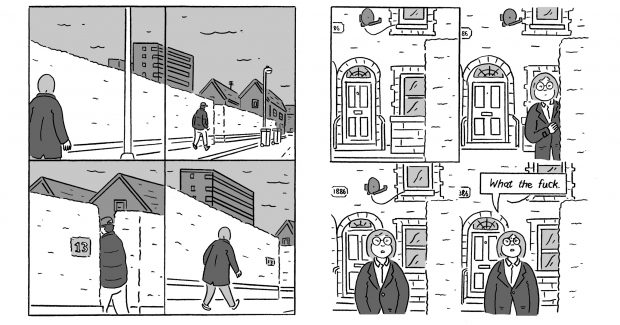
All three books have unique structures and approaches to telling stories, is it important for you to create comics which challenge the structure and convention of how to tell a story?
LH: Yes! Cuckoo’s Nest was intended to be a direct counterpoint to the kinds of mini comics that were especially popular while I was writing it in 2015: sparse, emotive and very un-dense, word count and narrative wise. I love lots of comics like that, but I wanted to make something that said specifically that those trends were not synonymous with quality.
I had just graduated from a comics program, and sometimes among the students, there was this notion that people had finally cracked how to make good comics in 2014 or something. I wanted to make something that would prove, to myself, that my particular tastes (dense, wordy, information heavy, unbombastic, patient) could produce good comics too.
I like it when work is a conscious reflection of the artist’s tastes and values. The particular formal approach of this book reflects the feelings I had while I was making it. My work moving forward may or may not do this same multimedia thing, but I hope I can continue to find new ways to express my values as effectively as possible.
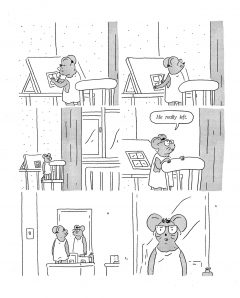 Your work is very meticulous and precise, do you think that shapes the kinds of stories you tell? And does it reflect you as a person?
Your work is very meticulous and precise, do you think that shapes the kinds of stories you tell? And does it reflect you as a person?
LH: Sometimes! Certainly in the case of this book. I like books with a lot of meat on their bones. Books that you can re-read, and still enjoy, and for me as a writer, this density and interconnectivity is the best way I’ve found to provide that.
As a visual artist, I’m super sloppy, haha. My drawings are clean, but I work fast, and tend not to correct mistakes. I only realised the other day, when I made a particularly bad error, that I didn’t own an eraser, and haven’t in years. So in that regard, I’m a total mess.
I also am a fairly relaxed person. I tend not to sweat the little things, except in my comics writing for some reason!
When we saw you at ELCAF, I think you mentioned you had just moved to the UK, is that right? How are you finding it so far? How is it inspiring your work in different ways?
LH: I love it here. I’ve been living in London for about nine months, and I’m planning to stay for the foreseeable future at least.
I’m not sure if my work is feeling the effects of the move yet, though I’ve certainly had a few more opportunities because of my new location, which has in some ways made it easier to work on comics full time.
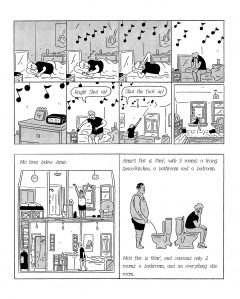
I have also been spending a lot of time in and around the London comedy community, which will I’m sure make good inspiration for future work.
And finally, what are you working on at the moment? More long form stories, or something shorter?
LH: I am working on a few projects at the moment. My main focus is on another graphic novel, this one a memoir about travelling across the United States on foot, which will be out in 2019.
I’m working on some pitches for animated TV shows, with some TV writers. I’m working on a short comic about gentrification in East London, possibly for the web, possibly to self-publish as a minicomic. Also, I’m starting a ten week run as a player in a comedy show in Camden in April (performance lab at the FA’s comedy room) so that should be a fun new challenge!
I’m also always available for freelance illustration and comic colouring, so if any of your readers is in need, they should feel free to hit me up!
Permanent Press can be pre-ordered from the Avery Hill store here. And to discover more of Luke’s work then visit lukewhealy.com



October 9, 2025 @ 4:42 am
This content stands out from the rest. Watch equidia tv live stream — live horse racing, Quinté+ analysis, pronostics, replays, and results. HD streaming with expert commentary and a comprehensive programme guide.
December 20, 2025 @ 2:38 am
Ja, um unsere Spiele spielen zu können brauchst Du den Adobe® FlashPlayer 10 oder höher und JAVA muss
auf Deinem Endgerät aktiviert sein. Nach Registrierung kann jeder
unsere Spiele mit dem „Ausprobieren-Modus“ spielen. Der Login ist die wiederkehrende Aktion, bei der Sie Ihren Benutzernamen und Ihr Passwort verwenden, um auf Ihr
bestehendes Konto zuzugreifen und zu spielen. Diese proaktive Denkweise unterscheidet Gelegenheitsspieler von wahren Gaming-Enthusiasten.
Und man muss einfach auch zugeben, dass es viel mehr Nervenkitzel erzeugt, wenn
es bei dem Spiel um echtes Geld geht und wir eben auch echtes Geld verlieren oder vor allem gewinnen können. Warum also nicht unterwegs
einfach ein Spiel wagen? Denn das gesamte Platincasino
ist in moderner HTML5 – Technologie programmiert
und vom Design her so aufgebaut, dass sich das Casino an Dein Endgerät
und an die Größe des Displays anpasst. Der sehr große Vorteil im
Platincasino liegt darin, dass Du keine eigene App benötigst, um
das Casino auch auf Deinem Smartphone oder Deinem
Tablet zu nutzen. Für die Einzahlungen im Platincasino
stehen Dir viele unterschiedliche Zahlungsanbieter zur Verfügung.
Wenn Du die aktuell angesagtesten Slots kennenlernen möchtest, dann
schau Dir im Platincasino die Liste der Top Spiele an.
Danach können Sie problemlos Einzahlungen vornehmen, spielen und Gewinne
auszahlen lassen. Die Auswahl an Tischspielen und Slots ist hervorragend, aber das Live-Casino hat es mir besonders angetan. Was mir besonders gefällt, ist die Möglichkeit, auch unterwegs über
die App zu spielen. Wer also in Deutschland im Platincasino spielt,
kann sich auf Seriosität und einen rechtlich abgesicherten Rahmen verlassen. Für deutsche Spieler bedeutet
das, dass Platin Online Casino nach europäischen Standards geprüft wird
und damit ein sicheres Umfeld bietet. So genießen Nutzer
bei Platincasino ein sicheres Umfeld, das Platincasino Seriosität und Fairness in den Vordergrund stellt.
References:
https://online-spielhallen.de/spinanga-casino-login-ihr-tor-zur-welt-des-online-glucksspiels/
December 26, 2025 @ 5:00 pm
Star Entertainment is the owner of Treasury Casino in Brisbane with this company one of
the biggest gambling operators in Australia. Australians can also sign up at many of
the best online bookmakers in the world. The Treasury is due to be
replaced by a development at Queens Wharf sometime in 2022, although this could change with
the current covid-impacted global climate.
Make yourself at home with complimentary parking and maximise your downtime with guaranteed late checkout at noon. With 20% off luxury stays at Treasury
Brisbane, plus more delicious perks, it is the perfect time to book your getaway.
The Treasury Casino is well worth a visit next time you are
in the Brisbane CBD.
The courtyard at the centre of the building was roofed over for the
conversion. The exterior of the building is highly intact while the interior has had only minor
modifications. Two wings containing toilets and washrooms project into the courtyard space.The
building has restrained rendered and painted interiors that feature cedar
joinery and ornamental plasterwork. The structure of the third
phase of the building consists of reinforced concrete slabs
supported on loadbearing masonry columns and steel girders.
References:
https://blackcoin.co/wd40-casino-in-australia-real-money-play-and-win/
December 27, 2025 @ 11:40 am
Whether you’re relaxing at home or sneaking a spin during
your commute, Woo Casino mobile ensures the action is always right there in your
hand. That means the same jackpots, same live dealer streams, and same promotions – just built for life
on the move. The dedicated Woo Casino app (also available as a Woo Casino mobile app) makes
it even easier to dive in. From welcome packs to regular promos,
every stage of play at Woo Casino Australia feels
like you’re getting more for your money.
And Woo Casino bonus deals are some of the most generous
around. High-definition streams, pro dealers, and
interactive features bring that authentic casino vibe straight to your screen.
With quick navigation, touch-friendly controls, and instant
access to 10,000+ pokies and table games, it’s
designed for players who want everything just
a tap away. With over 10,000 titles on the roster – from
classic pokies to the latest live dealer experiences – this is the Woo online casino built for Aussie players who want
the lot. Woo casino transforms your gaming routine with instant deposits, withdrawals processed within 1-24 hours, and round-the-clock support tailored specifically for Aussies.
Woo Casino Australia appeared on the gambling market in 2020, bringing thousands of casino games and huge bonuses to the table.
Woo Casino offers a premium online gaming experience with over 2,
000 games, generous bonuses, and secure payment options.
December 29, 2025 @ 5:47 am
paypal neteller
References:
applunch.site
December 29, 2025 @ 6:11 am
usa casino online paypal
References:
customer-callcenter74.pe.kr